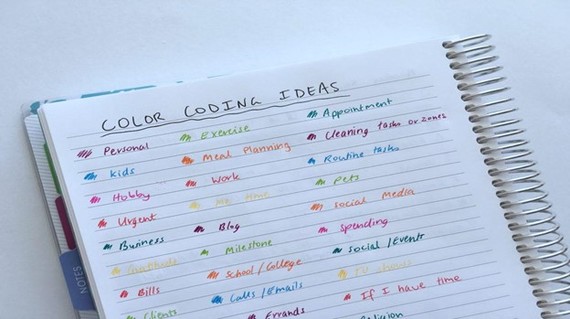Studying our notes is probably something we should do. But let’s be honest, most of us don’t even know what that means. And from today’s post you’re going to learn how to study your notes by color-coding them, no matter what note-taking method you use.
Why Color-Code Your Notes?
First let’s talk about the purpose of color coding or highlighting your notes. First, humans are very forgetful. So, even if you take note of something and don’t look at it soon after you write it down, the odds are good you’ll forget what you’ve written eventually. And sometimes, note taking can seem like a meaningless task and time waster. You’re listening and reading something, and then you’re writing it down on a piece of paper. When you color-code your notes, though, you think about the information at hand and tend to organize it in a more meaningful way.
It would be wise to take 10-15 minutes right after taking your notes and color-code the essential information, while it’s still fresh. In this case, you’ll succeed in brushing up on your knowledge after you look through your notes. You can adopt any note-taking method you regard as the most convenient. You can underline, circle, highlight, bold, or use different colors to accentuate the facts, definitions, and other important points in your writing. The possibilities are truly endless here. The whole point is you have a whole system that works for you and you stick to it. So, be consistent.
It’s also important to keep in mind that the way you color-code your notes can change slightly based on the subject or topic you’re taking notes on.

Creating Your Own Color-Code System
It’s a good idea to write down your central question in red, and then you can highlight any information that directly relates or provides an answer to your question. Should there be any need to define any key words, you may want to write them in bold. Your summaries or conclusions might appear in green or any other color you think is fit for that purpose. Note that there’s nothing special about these colors. The only thing you want to do is ensure you’re using this or that color consistently not to disrupt the entire note-taking system and hinder the efficiency of your studying process. If you do everything correctly, when you look at your notes weeks or even months later, your brain will quickly retrieve the essential information.
Useful tip!
You can use dedicated apps to make the note-taking process easier and faster. If you want to go even more sophisticated, you may take advantage of graphic design tools, which allow you to utilize the richest color palettes and choose among a multitude of hues and colors for color-coding your notes. Go to Create.vista.com and learn more!
In History classes, you might also want to color-code any important dates, people names, major historical events, causes and effects, and the like. In English classes, you may want to focus on inferences, characters, setting, or themes when reading a certain literary piece. As for your Science classes, try to focus on observing certain processes, data collected, key terms, etc. As it has been emphasized earlier, such a system will make it possible for you to design your unique and highly effective note-taking system that will go a long way in helping you study more efficiently.
Points to Focus on When Taking Notes
The system you’ve developed may change slightly as you go along. And minor deviations are commonplace. But to be able to keep a lid on the entire process, you want to do the following:
- At first, look for important information in the text you’re working on
- Identify the chunks of text that require your particular attention
- Single out definitions, dates, events, and other facts you need to memorize
- Color-code the essential information using the color-coding system you’ve developed.
Hopefully, these simple recommendations will help you get the most out of your note taking process and boost your overall academic performance.










